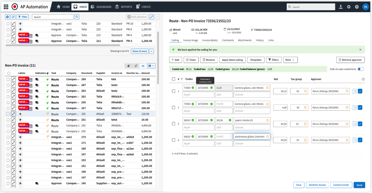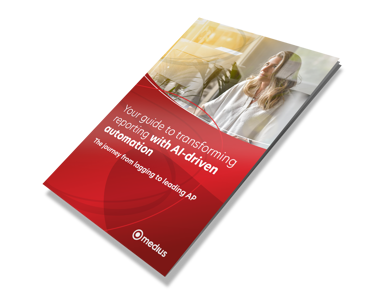Mastering year-end close in 2025: essential checklist for AP teams
By Meredith Grace
- Introduction
- Understanding year-end close in accounts payable
- How AI and automation improve the year-end close process
- Don’t wait until next year to work smarter
- Year-end close vs. month-end close
- New digital compliance priorities
- Typical timeline for year-end close
- Common pitfalls of manual year-end close and how to avoid them
- Get your checklist for mastering the year-end close
- How a successful year-end close prepares your AP team for 2025
Hear what's covered in this article:
Year-end can feel like a whirlwind for finance teams, especially accounts payable (AP). From finalizing expenses to balancing accounts and preparing for audits, the demands can quickly pile up. With tight deadlines, manual processes often lead to delays and an increased risk of errors. However, with AI-driven solutions, you can tackle these tasks faster and more accurately, allowing a smoother transition into the new stress-free fiscal year.
Staying ahead in 2025
As finance teams face tighter reporting deadlines and evolving digital tax mandates, automation is no longer just a convenience, it’s a necessity. In 2025, leading AP departments are leveraging AI tools to handle everything from invoice matching to anomaly detection, reducing close time while maintaining compliance across global markets.

Understanding year-end close in accounts payable
The year-end close is critical, marking the final reconciliation of all accounts payable transactions. Your goal is to provide a complete and accurate snapshot of your organization’s financial position, which is essential for compliance, reporting, and strategic planning. Unlike month-end close, year-end close has a broader scope and a greater impact on financial reporting.
In 2025, this process carries added significance. With new e-invoicing and data validation standards rolling out globally, year-end close isn’t just about balancing the books—it’s about ensuring full digital traceability and compliance. Having automation integrated into your AP workflows ensures all transactions, from invoices to payments, are properly validated and audit-ready.
Key steps in the year-end close process:
- Reconcile accounts
Make sure all transactions match, from invoices to payments. - Audit preparation
Organize and validate records for a seamless audit. - Adjustments and accruals
Account for unrecorded expenses or liabilities. - Vendor reconciliation
Confirm all outstanding balances with vendors. - Budgeting and strategic planning
Use insights from year-end data to guide the upcoming year’s plans.

Consider adding automated reporting and analytics tools to your close process. Modern AP systems can now generate dashboards that highlight discrepancies or missing documentation before they cause delays, giving teams a clearer path to accurate reconciliation.
How AI and automation improve the year-end close process
Manual year-end close processes are often slow and prone to error, causing delays and potential compliance issues. Using AI-driven automation tools can alleviate these concerns. Here are a few ways how:
Speed and accuracy with AI-driven invoice processing
Advanced AI tools streamline invoice processing and validation. By using data-matching capabilities, these tools help you verify invoice details with ease and provide the information needed to clear open invoices quickly. Automating these tasks reduces bottlenecks and keeps your year-end close on track.
Simplifying supplier communication with automated interactions
Automated vendor communication tools can help you efficiently resolve open invoices and other outstanding issues with vendors. These tools offer real-time updates and virtual communications to resolve discrepancies automatically, keep vendor data accurate, and reduce the risk of missed payments or mistakes. Automating these interactions can strengthen vendor relationships and ensure a smooth, efficient year-end close.
Smarter exception handling
AI capabilities in today’s AP systems don’t just automate routine processes—they identify outliers, such as duplicate invoices or unusual payment patterns, helping teams mitigate risk before year-end. By using these predictive insights, finance leaders can prevent costly errors while maintaining healthy supplier relationships.
Don’t wait until next year to work smarter
Year-end is the perfect time to fix what slowed you down this year. With AI-driven AP automation, reporting becomes faster, clearer, and far less stressful, so you can start the new year focused on strategy, not spreadsheets. Discover how leading finance teams are transforming reporting and decision-making in "Your guide to transforming reporting with AI-driven automation."
Year-end close vs. month-end close:
key differences in AP
Although month-end and year-end close have similar tasks, they differ significantly in scope and purpose.
| Month-end close | Year-end close | |
|---|---|---|
| Scope | Focuses on monthly transactions. | Covers entire fiscal year transactions. |
| Frequency | Conducted monthly. | Annually, at the end of the fiscal year. |
| Purpose | Supports operational decision-making. | Informs strategic planning and compliance reporting. |
| Reporting | Primarily internal. | Internal and external, including regulatory filings. |
Because of its broader scope, the year-end close offers a unique opportunity to evaluate your AP process. Teams using automation can compare close cycle times, approval delays, and exception volumes across months to identify bottlenecks, turning what was once a stressful scramble into a data-driven improvement plan.
New digital compliance priorities
With more countries implementing real-time reporting and continuous transaction controls, having a connected AP system is critical. Automated solutions like Medius ensure your invoice data complies with these local mandates while providing a full audit trail—helping teams stay compliant without slowing down operations.

Typical timeline for year-end close
While timelines can vary depending on your organization, here’s a general framework to follow for a successful year-end close:
-
Pre-year end (3-4 months before)
Assessment and planning:
Review current AP processes and plan for any necessary adjustments.Documentation review:
Ensure that invoices, receipts, and payment records are organized. -
Year-end close kickoff (2 months before):
Data cleanup:
Address outstanding vendor issues and ensure accurate AP records.Communication and training:
Align expectations with stakeholders and ensure everyone understands their role in the close process. -
Final countdown (1 month before):
Reconciliation of accounts:
Verify invoices, validate payments, and resolve discrepancies.Audit preparation:
Ensure records comply and ready for audit. -
End of fiscal year:
Financial statement preparation:
Work with other financial teams to integrate accurate AP data.Accruals and adjustments:
Record any unaccounted-for expenses or liabilities for accuracy in reporting.
Use automation to manage your timeline
Modern AP platforms allow teams to set reminders and workflow checkpoints throughout the closing period. Automated notifications help keep everyone on track and ensure no invoice, approval, or reconciliation step falls behind schedule.
Common pitfalls of manual year-end close and how to avoid them
Relying on manual processes can lead to setbacks during year-end close. If you want to stay ahead, you must invest in automation (particularly AI-driven automation) to help you avoid these common challenges:
Increased risk of errors
Manual data entry mistakes can impact accuracy. Automation minimizes these with data validation.
Delayed timelines
Manual processes slow down AP. Automation speeds up invoice processing and reconciliations.
Compliance risks
Manually tracking requirements may lead to missed updates. Automation keeps you aligned with regulations.
Incomplete data and insights
Inaccurate data hurts decision-making. Automation ensures comprehensive and accurate records.
Audit delays
Inconsistent data extends audits. Automation streamlines record-keeping for a smoother process.
The cost of inaction
Organizations that rely on manual reconciliation and paper-based processes often face late close penalties, delayed audits, and increased fraud exposure. As 2025 brings more digitized compliance requirements, teams without automation risk falling behind in both accuracy and transparency.
Get your checklist for mastering the year-end close
By now, you know the importance of year-end close in accounts payable and understand the basics of the process and its impacts. Below, we’ve provided a checklist with tips to help your AP team tackle year-end close like a pro—and set the foundation for years to come. If you want the full checklist, download it here. (Pro tip: AI-driven AP automation makes it all easier!)
Review and reconcile accounts
Before diving into year-end tasks, thoroughly review and reconcile all accounts. Identify discrepancies, outstanding invoices, and any unresolved issues. This proactive step sets the stage for accurate financial reporting, ensuring you start the new year with clean, reliable data.
Stay compliant
Compliance is critical, including adhering to tax regulations, reporting standards, and accounting protocols. Stay on top of any legislative changes affecting your AP function, such as new e-invoice mandates, tax codes, or regulatory deadlines. AI-powered AP automation tools can spot fraudulent accounts and establish robust compliance protocols, reducing tax, fraud, and regulatory risks.
Clear outstanding invoices
Check for outstanding invoices and aim to resolve them before year-end. This means following up with vendors, addressing discrepancies, and negotiating payment terms if necessary. Closing the year with minimal outstanding invoices ensures accurate financial statements and maintains strong vendor relationships. If you’re not using AI-driven automation, consider investing in a solution to keep records updated and avoid missed invoices.
Update vendor information
Ensure all vendor information is current, including contact details, payment preferences, and tax IDs. Accurate vendor data is essential for seamless transactions, and year-end is the perfect time to update these details for a smooth start in the new fiscal year.
Perform physical asset audits
If your organization manages physical assets, conduct an audit to ensure your records accurately reflect their location and status. AI can support this process by tracking asset data, flagging discrepancies, and providing insights for financial reporting.
Communicate clearly
Keep communication open with internal stakeholders, like procurement and finance teams, to address any unresolved issues. Relying solely on ERP data may not be enough. Effective communication ensures everyone is aligned and contributes to a smoother year-end close. The right AI-driven AP automation can offer the CFO accurate data for accrual reporting, cash flow forecasts, and financial audits—and even open up opportunities for discounts.
Plan for the future
Use year-end close as a time to assess and enhance your AP processes. Identify areas for improvement and plan for changes that will bring greater efficiency and accuracy in the coming year. This forward-thinking approach supports continuous improvement and long-term success for your AP team.
Strengthen your checklist with real-time visibility
Automation solutions now offer dashboards that visualize year-end readiness in real time, helping AP leaders identify bottlenecks, overdue invoices, or compliance risks instantly. With these tools, your checklist becomes more than a task list—it becomes an intelligent framework for performance improvement.
How a successful year-end close prepares your AP team for 2025
Completing an accurate and efficient year-end close sets the stage for a strong start to the new fiscal year. With clean records and reliable data, you’ll gain valuable insights to guide budgeting, resource allocation, and strategic planning. Automation tools not only improve data accuracy but also save time–give your AP team time to focus on continuous improvements and long-term success. You can do this. Set yourself up for success with Medius.

Looking ahead to 2026
Teams that invest in intelligent AP automation this year will find themselves better prepared for the evolving financial landscape. As global e-invoicing standards expand and AI tools advance, next year’s close will be faster, cleaner, and more strategic than ever.






